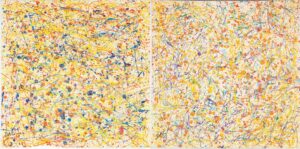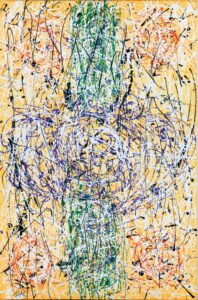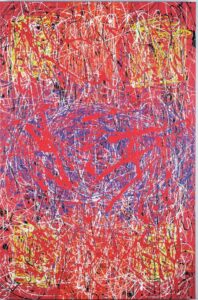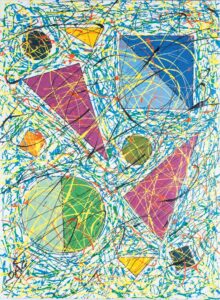Dorothy A, Culpepper is a woman of action. Gazing at her body of ork unleashes a vertiginous vocabulary of verbs within the viewer. “Rhythmic skeins,” as one reviewer described it, that swirl and swing, splash, splat and slide, glide and gallop; they clot, they cluster, they careen; they drift, they drip and drop across the expanses of her canvases.

“Among Marbles” 1 & 2 Dorothy A. Culpepper
In the style for which she is probably the best known now, we are reminded of Jackson Pollock, whom she had never met. But her “brush” is different. While it is just as gestural, it is more delicate. The lighter touch in her work is not to say that it is devoid of strength. Culpepper’s paintings combine both grace and gusto. At 83, Culpepper still paints her canvases spread out on the floor. The technique may be similar, but the “touch” is not. She has different lyrics to her song. As a Caribbean friend put it: “They jump, they jive, they jaunty.”
Something new has been added to this exhibit’s exuberant mix of linear lace-like tracery, lively lines against the more solid, but pale, near-transparent, geometry. Colorful structured shapes seemingly float—the “fractals” of the exhibit’s title—forms held aloft by a joyful breeze in some of these airy works. Reminiscent of kites, beach balls, even rectangular-shaped “envelopes” bearing unseen messages, they drift airborne onto a luminous background. These are exhibited side by side with her very gestural works, complementing, expanding and framing the fluid language of Culpepper’s artistic expression.
Twenty paintings will be exhibited in her upcoming solo show called “Fractals.” It is her 20th in the Montserrat Contemporary Art Gallery at 547 West 27th Street in Manhattan’s Chelsea, scheduled from July 15 to August 22.
For those not on familiar footing with fractals, the word comes from the French via Latin, meaning broken or uneven. Used in mathematical or the parlance of physics, they are essentially geometrical or physical structures having an irregular or uneven shape. What is neither broken, nor uneven, is Culpepper’s art. It follows an ever-ascending arc in works sometimes (once) mural-sized, sometimes intimate, always captivating. “I like to let people make up what they see…Each person should see something different.” In her view, communication, without a doubt, is in the eyes of the beholder. And “something different” should be Culpepper’s middle name.
Culpepper trips the bright fantastic with obvious joy. Her playfulness is manifest in these new works, perhaps more than ever before. They exude a light-hearted gaiety, a near-childlike flight of fancy—however sophisticated—a delight in life and living. Her works quite literally dance before our eyes.
“I have always been interested in painting ever since I was ten years old,” she says. Her parents, however, took a very dim view of any artistic ambition their daughter harbored, as was typical of the era when she was growing up. Women were supposed to be wives and mothers, and not—God forbid—artists. It could be said that she was a late bloomer. But bloom she did. “I read a lot of books, joined art groups, worked in oils, watercolors and acrylics. Art had always been in the back of my mind.” Culpepper took up her brushes in a serious way when she was 40. As she expressed it, “Painting just took over.” Jackson Pollock’s style intrigued her—to whom she has been compared, but never met. Painting on the floor, she explains, is “natural” to her.
She also admires many other artists whose artistic expressions are very dissimilar to her own: they include Helen Frankenthaler, with whom she studied, Nancy Graves, Kenneth Noland and Paul Jenkins.
A native of Cincinnati, Culpepper now lives in New Mexico. “Landscapes have always influenced me. Earth colors, flowers, the colors of the West inspired me.” An unpretentious and modest artist, she intimates that her paintings all but paint themselves. “A lot of my paintings come from the inside. They have a
mind of their own.” If that’s the case, then the only mind they have must be Culpepper’s.
With respect to her current incorporation of structural shapes into her gestural action images, she explains the evolution with typical self-effacement. “I had done pencil on paper shapes before. Then I needed to do something different [for the acrylic works]. I would draw freeform, then outline them—a
geometric shape here, a triangle there—lines over them. I would just start and some things just happened.”
“I am an action painter—an Abstract Expressionist—but I started out as an Impressionist. I painted landscapes, as well as portraits, which I turned into Picassos.” Now, Culpepper paints intuitively. As she puts it, “Expression is what I do when I paint. I just do it. I don’t actually think about it. It just flows.” The energy emanating from her work suggests immediacy, a fast-paced timing. Not
necessarily so. “Sometimes I wait a while. It depends on how I feel, and the weather.” That said, she describes herself as active. “I want to be busy and enjoy life.” One is left convinced that she is doing just exactly that. The twin paintings, “Among the Marbles” #1 and #2, are sun-filled images, as fun as their titles suggest, where an itinerary of lines and small splats—visual clinks of imaginary unheard sounds–suggests the game we used to play as children—those of “a certain age” before the digital era.

“Storm”
“Storm,” evokes the vortex, the blue eye of a tempest, where windblown strands and gusts of wind whirl, whipping elements about–perhaps debris—against a sun-soaked, summer-buttery backdrop. Dark threads spread and splay, sew together the background, weaving the proverbial tangled web.
“Purple Kite Down” is the perfect illustration of where Culpepper’s action painting and fractals zombine—linear trails of various guidelines steering multishaped forms; “kites” take to the air, save one—the “purple kite” seems not to crash land, but to descend delicately toward an unseen ground. “Beyond Stargate” is a variation on the same theme. Geometric forms such as triangles and circles are held aloft, slow-dancing against sunlight. “Red Rain” dramatically pounds the unsuspecting—a sudden downpour of lifeblood and thunder. Despite the brilliance of color, the image somehow depicts an impending darkness, an ominous note of sorts.

“Red Rain”
That fluidity of her “flow” translates into something musical about Culpepper’s art. There is a rhythm, a beat, an imaginary score that emerges in the mind’s eye. Not surprising. She often works while listening to music. And what kind of music might that be? “Rock and roll,” comes the unexpected response, faster than you would expect it. “Guns and Roses, Metallica. Oh, and I like jazz, too.”
Montserrat’s gallery director, Richard Gins, agrees: “Dorothy has her interests and stylistic preferences…over the years, she has pushed those interests into new territory in each of her shows. I always look forward to her exhibitions, because she always surprises me with something new and added. I’m sure her new show will also have surprises that redefine her work.”
Get ready. Culpepper, now in her eighth decade, looks forward. She wants to deliver “something that hasn’t been seen before,“ she says. “I like to keep the imagination going.” She is already thinking about “something new and added” for the 2016 show. Her imagination, like miracles, never ceases. Youthfulness of spirit has no age. Culpepper is a case in point. Don’t look now, but she will soon be dancing to a different drummer without losing a beat. And she will surprise us all. Again.

“Beyond Star Gate




